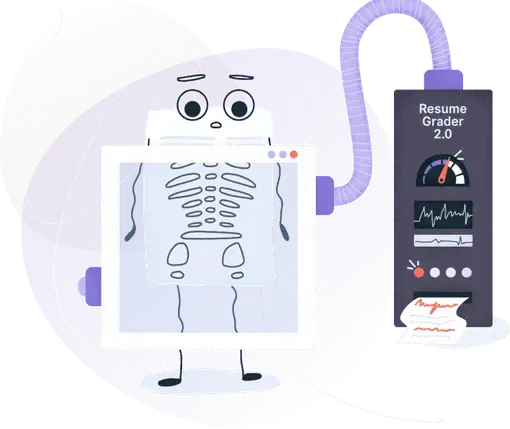Process Improvement Skills: Example Usage on Resumes, Skill Set & Top Keywords in 2025
Including process improvement on your resume signals to recruiters that you possess a proactive attitude and a focus on efficiency in problem-solving. Dive into the guide below to discover powerful ways to frame your skills and elevate your job application.


Is your resume ATS-friendly?
Drop your resume here or upload a file to find out if the skills in your resume are readable by an ATS.
Process improvement is a skill that focuses on analyzing and enhancing business processes to increase efficiency and quality. It involves identifying bottlenecks, streamlining workflows, and implementing solutions that result in better performance and outcomes. By developing the ability to improve processes, individuals can help businesses save time and resources, while also reducing errors and improving customer satisfaction. It's a valuable skill because it demonstrates a person's capability to contribute to the bottom line and promote growth within an organization.
Including the process improvement skill on your resume can show potential employers that you have a proactive approach to problem-solving and are equipped with the ability to make significant contributions to a company. However, be cautious about overemphasizing this skill if you cannot substantiate it with concrete examples or if it overshadows other important qualifications. Instead of just listing 'process improvement' as a standalone skill, it can be more effective to integrate examples of how you've applied this skill into your work experience. This approach not only validates your claim but also gives a clearer picture of your capabilities to employers.
In this article, you will learn:
- The potential drawbacks of adding "process improvement" to your resume without supporting evidence.
- How to effectively showcase your process improvement skills with real-world examples.
- Synonyms and alternative phrases to describe your process improvement abilities.
Misusage of process improvement on resumes
Process improvement skills are a critical asset, reflecting an ability to enhance workflows and increase efficiency within an organization. However, showcasing this skill on your resume requires careful consideration to avoid misrepresentation. Overstating your abilities or inserting phrases that don't accurately reflect your experience can undermine your credibility and potentially lead to challenges in a new role if you can't deliver on promised proficiency levels.
- In the summary section, an example of misuse would be claiming "Revolutionized company procedures with innovative process improvement techniques" when you've only played a minor role in these projects.
- Within the experience section, stating "Led a high-impact team in deploying advanced process improvement strategies to double productivity" can be misleading if the productivity increase was marginal or not directly linked to your input.
- For the achievements section, writing "Awarded Process Improvement Expert of the Year for pioneering industry-leading practices" is an overstatement if the award was for a team effort or for a smaller, internal company recognition rather than an industry-wide accolade.
How to demonstrate process improvement skills on your resume
- Quantify your achievements by detailing how you've improved efficiency, reduced costs, or accelerated processes with specific percentages and metrics.
- Highlight any certifications or training you have in process improvement methodologies like Lean, Six Sigma, or Kaizen.
- Describe how you identified opportunities for improvement, developed a plan of action, and led cross-functional teams to implement changes.
- Share examples of how you've analyzed data to make informed decisions which led to process enhancements.
- Include any tools or software you've used to map out processes, track performance, and report on progress improvements.
Example 1: Demonstrate process improvement in the experience section
- •Spearheaded the cross-departmental initiative to automate inventory tracking, reducing errors by 30% and saving $200K annually.
- •Implemented a new performance metrics system that increased team productivity by 25% within the first year.
- •Negotiated with suppliers to cut material costs by 15%, saving the company $75K each quarter without compromising quality.
- •Developed a supplier audit program that led to 20% improvement in raw material quality and extended shelf life of products by 2 weeks.
- •Orchestrated an overhaul of the QA process, resulting in a 50% reduction in customer complaints related to product quality.
- •Initiated regular staff training on quality standards, which contributed to a 40% decrease in internal rework and waste.
- •Drove the completion of a multimillion-dollar IT infrastructure upgrade on time and 10% under budget.
- •Coordinated a product launch that penetrated a new market segment, increasing company revenue by 18% in its first year.
- •Introduced agile project management methods that shortened the average project lifecycle by three weeks.
- This work experience showcase is strong because it provides concrete evidence of process improvement through real-world examples.
- The bullet points are effectively crafted to show not just tasks but also the positive outcomes, like cost savings and productivity gains, directly linked to the work done.
- Each point gives a clear picture of a specific project and the individual's role in achieving tangible business results.
- Varying language and detailed descriptions are used, which keeps the reader engaged and illustrates a diverse skill set.
- The use of quantifiable achievements makes the experience tangible for potential employers, helping them to visualize the applicant's capability.
Example 2: Demonstrate process improvement in the summary section
Why this summary is effective for a candidate with excel skills:
- It directly states the candidate's years of experience, showing depth in their field.
- The summary highlights the applicant's relevant technical skills by mentioning software development and process optimization, both of which are pertinent to Excel expertise.
- It conveys a concrete career achievement with a quantifiable outcome, demonstrating the effectiveness of their work.
- The text emphasizes the candidate's proactive problem-solving skills, which are essential when working with data and Excel spreadsheets.
- The language used is simple and direct, avoiding any unnecessary jargon or buzzwords, making it accessible to a wide audience.
- Every sentence adds value, showcasing the candidate's abilities and dedication without digressing into unrelated details.
Example 3: Demonstrate process improvement in the achievements section
- The achievements clearly show measurable outcomes, which demonstrate the ability to deliver results.
- Descriptions are concise and factual, highlighting significant impacts without excessive jargon.
- Use of percentages and specific improvements make it clear what the applicant achieved in their role.
- Each achievement reflects direct involvement in projects or initiatives, creating a picture of an active and effective individual.
- The language is straightforward, making the content accessible to readers of all levels.
What are the relevant certifications for process improvement skills on resume
To bolster your resume and skills in process improvement, consider obtaining the following professional certifications:
The top 5 certifications for gaining process improvement skills expertise:
Top skills people add together with process improvement skill on resume:
Lean Six Sigma
Project Management
Data Analysis
Continuous Improvement
Quality Management
Workflow Optimization
Root Cause Analysis
Business Process Mapping
Statistical Analysis
Operations Management
Problem-Solving
Attention to Detail
Leadership
Communication
Teamwork
Organizational
Adaptability
Critical Thinking
Time Management
Proactivity
Decision-Making
Most relevant jobs for process improvement skills
Jobs that require process improvement skills are essential in any efficiency-driven industry. Professionals in these roles focus on enhancing performance by evaluating workflows, identifying inefficiencies, and implementing strategies to increase productivity and reduce costs. These positions are typically found in various sectors from manufacturing to healthcare, where systematic procedures are vital for success.
- Process improvement specialist
- Operations manager
- Business analyst
- Quality assurance manager
- Lean Six Sigma consultant
- Project manager
- Supply chain analyst
- Continuous improvement engineer
- Healthcare quality improvement coordinator
- Performance improvement manager
Key takeaways
- Process improvement skills bolster your resume by showing your ability to enhance business operations.
- Avoid misusing these skills by understanding their proper application and setting realistic goals.
- Showcase this skill on your resume by providing concrete examples of past process optimizations and their results.
Make one that's truly you.




